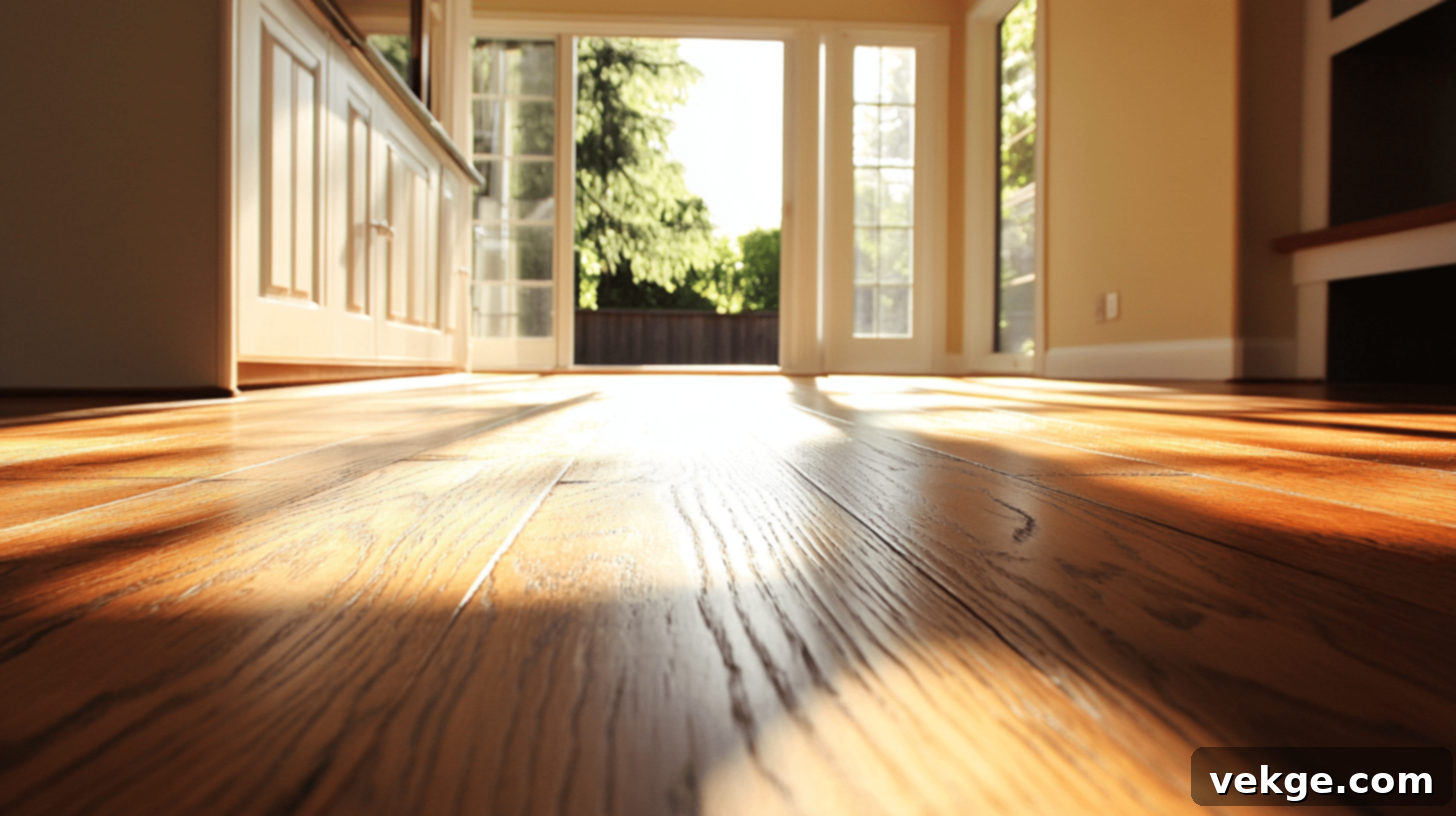15 Captivating Hardwood Floor Designs: Styles, Costs & Installation Guide
Hardwood floors are more than just a surface to walk on; they are a foundational element that can profoundly transform any house into a warm, inviting home. They infuse spaces with timeless character, unparalleled elegance, and significantly enhance property value. Choosing the right hardwood floor design is a critical decision that can elevate an ordinary room into a stunning showcase, setting the perfect aesthetic tone for your entire living environment.
Whether your personal style gravitates towards the enduring charm of classic elegance or the sleek allure of modern flair, a carefully selected hardwood floor design has the power to bring your unique vision to life. The vast array of wood species, plank widths, and intricate patterns available means there’s a perfect match for every taste and functional requirement.
In this comprehensive guide, we will embark on an exciting journey to explore 15 captivating hardwood floor designs that promise to elevate your home’s interior. From beloved, timeless patterns that have graced homes for centuries to innovative and unique layouts that push design boundaries, these options cater to a diverse spectrum of aesthetic preferences and architectural styles. We will delve deep into the distinct characteristics of each design, providing insights into their visual impact, inherent durability, and optimal suitability for various rooms and lifestyles.
By the conclusion of this guide, you will be equipped with the knowledge and inspiration needed to confidently choose a hardwood floor design that not only flawlessly complements your home’s existing architecture and decor but also beautifully reflects your personal style and practical needs. Let’s discover the perfect foundation for your dream home.
Discover 15 Stunning Hardwood Floor Designs for Every Style
1. Classic Oak Plank
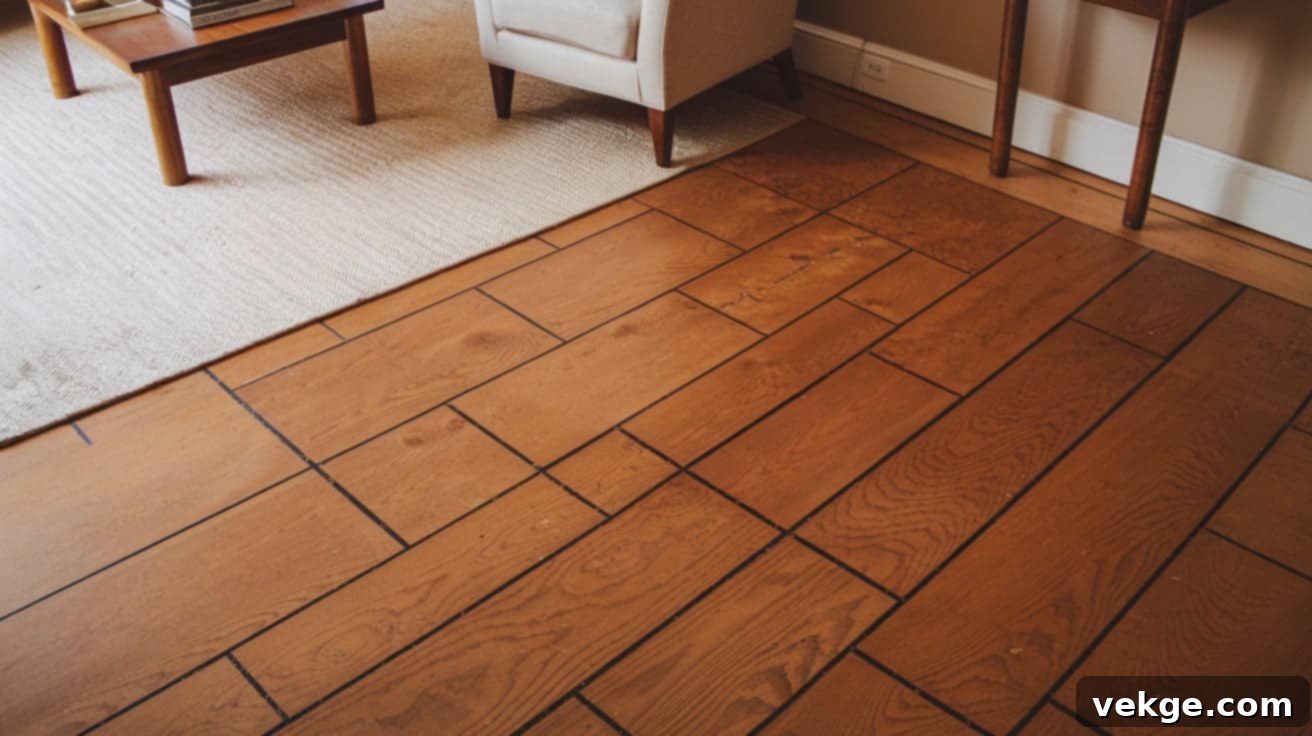
Oak plank flooring stands as a truly timeless choice, revered for its exceptional durability, inherent versatility, and classic appeal. This design typically features long, solid strips of oak wood laid in a straightforward, parallel pattern, creating a clean, traditional, and endlessly elegant look. Oak’s natural grain patterns and warm tones adapt beautifully to a wide range of interior styles, from rustic farmhouses to formal living spaces.
- Durability: Renowned for being highly resistant to dents, scratches, and general wear and tear, making it an excellent choice for even the busiest, high-traffic areas of your home. It’s a species that truly stands the test of time.
- Ideal Locations: Its robustness and aesthetic flexibility make it suitable for virtually any room. It’s particularly popular in living rooms, dining rooms, bedrooms, and hallways, providing a consistent and inviting foundation throughout the home.
2. Herringbone Pattern
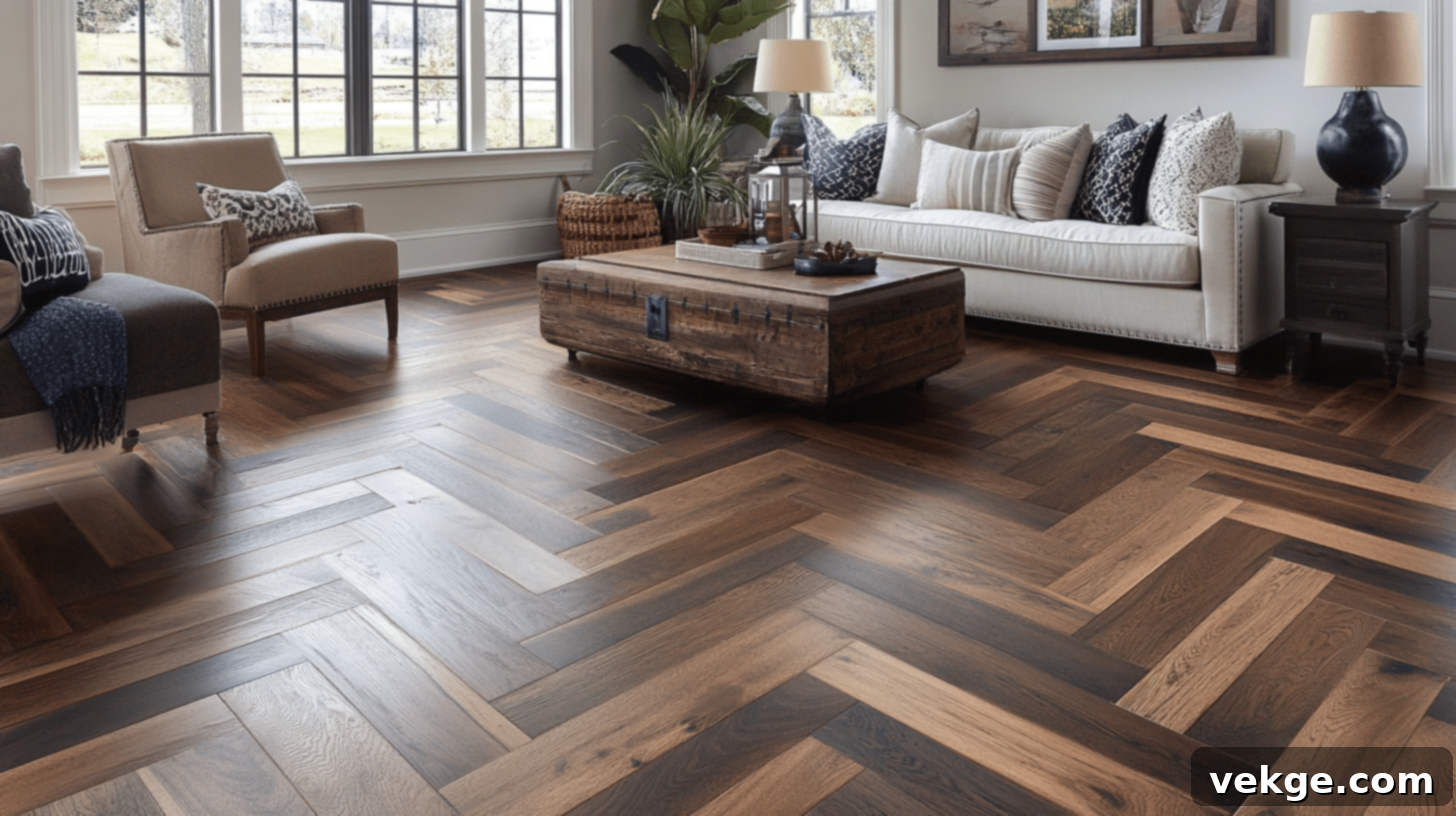
The herringbone pattern is a hallmark of sophistication and historical charm. This design artfully arranges rectangular wood pieces, cut to precise dimensions, in a distinctive zigzag pattern. Each plank meets at a 90-degree angle, creating a series of broken V-shapes that are visually striking and add immense depth and a sense of movement to any room. Herringbone can instantly elevate an interior, offering a luxurious feel reminiscent of grand European estates.
- Durability: While the specific durability depends on the wood type chosen (oak, walnut, etc.), the intricate interlocking pattern inherently provides good stability and wear resistance.
- Ideal Locations: Best suited for formal living rooms, elegant entryways, or as a magnificent accent in larger, open-concept spaces. It creates a powerful statement and works wonderfully in both traditional and contemporary settings.
3. Wide Plank Walnut
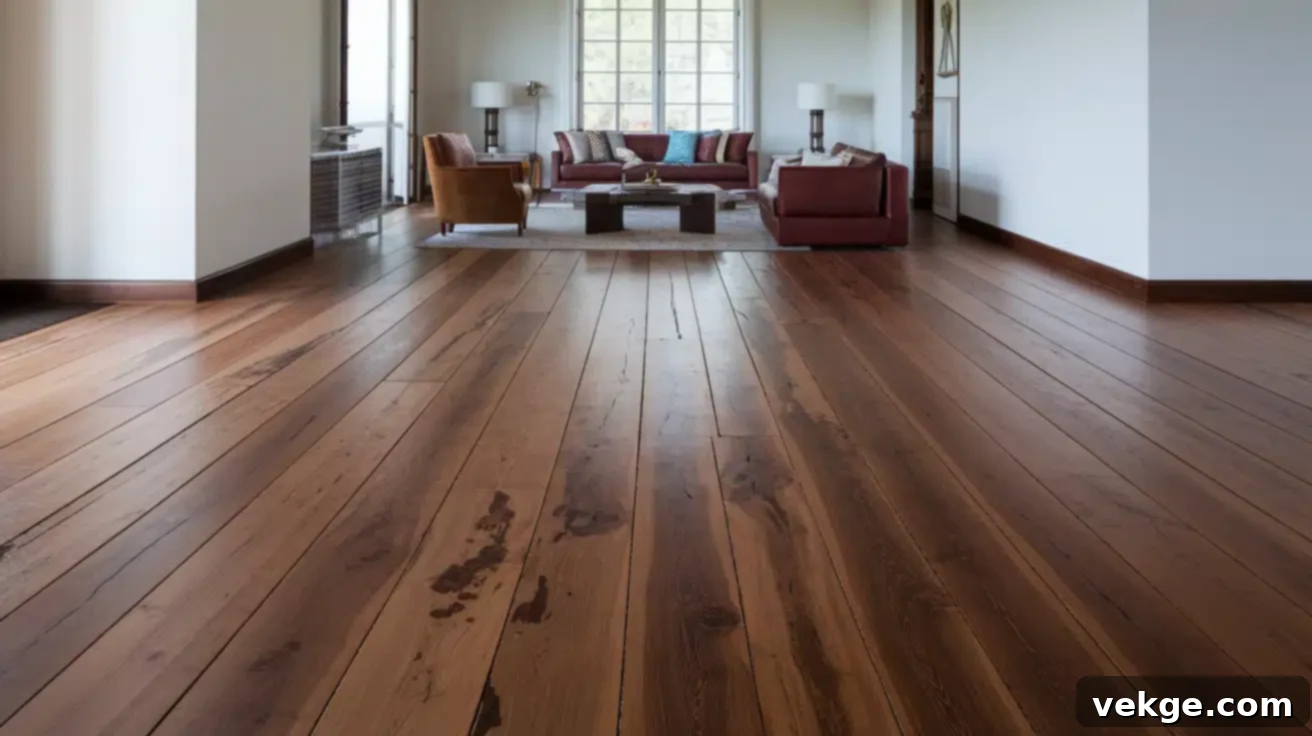
Wide plank walnut flooring epitomizes a sense of grandeur and natural beauty. By utilizing broader boards, this design magnificently showcases walnut wood’s exceptionally rich, deep brown colors and its naturally swirling, unique grain patterns. The expansive planks minimize seams, creating a more cohesive and flowing visual effect that imparts a distinct sense of spaciousness and understated luxury. Walnut’s inherent warmth adds a sophisticated touch to any interior.
- Durability: Walnut is considered a moderately hard wood. While durable, it may show more signs of wear or dents in areas with extremely high foot traffic compared to harder species like oak or hickory.
- Ideal Locations: Perfectly suited for rooms where a luxurious and refined atmosphere is desired, such as formal dining rooms, elegant studies, or serene master bedrooms. Its distinctive appearance makes it a focal point.
4. Reclaimed Barn Wood
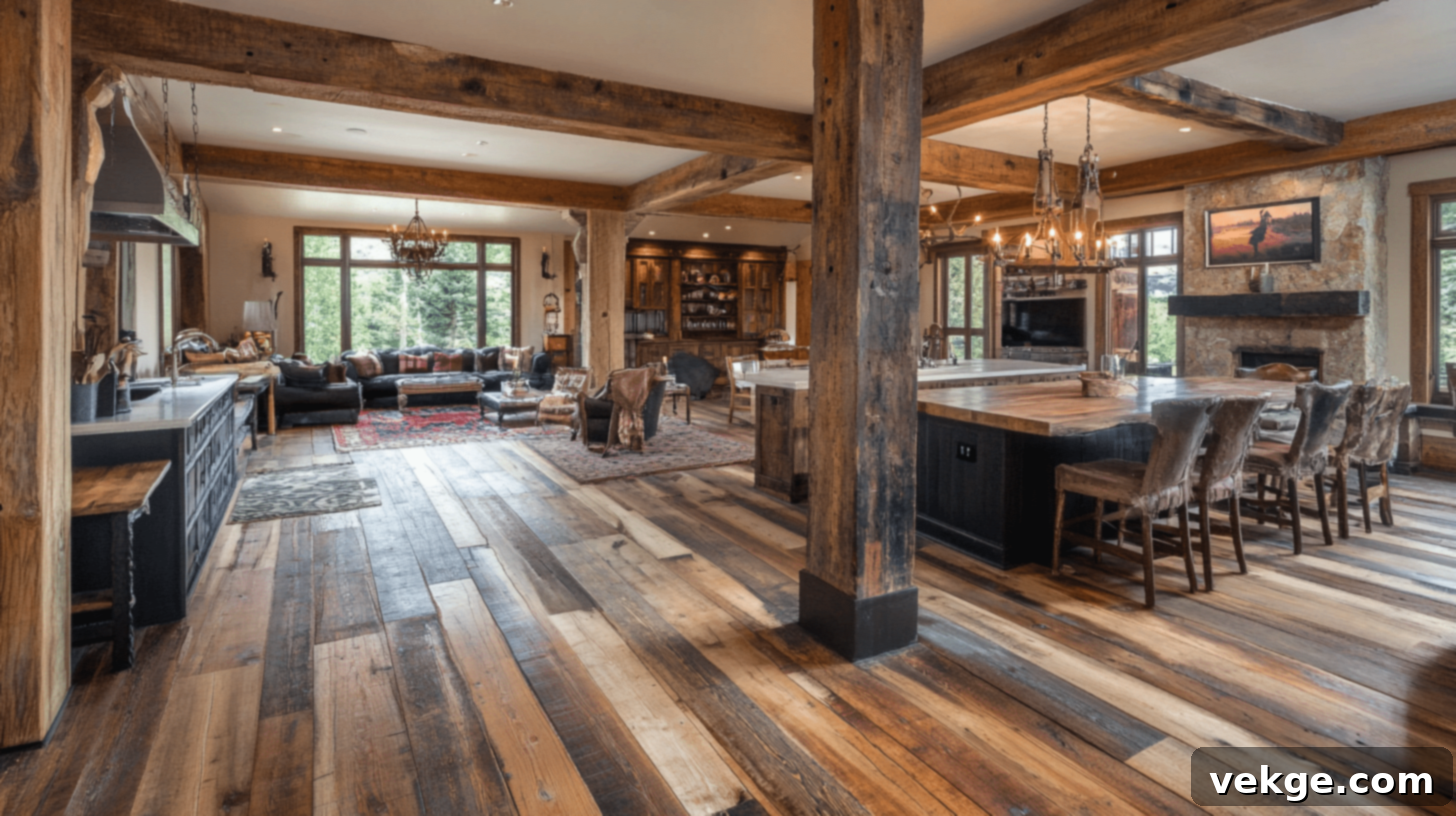
Reclaimed barn wood flooring offers a rustic, deeply characterful, and inherently eco-friendly option for homeowners seeking a connection to history and sustainability. This unique flooring utilizes salvaged timber from old barns, factories, or other venerable structures. Each plank comes with its own rich history, evident in its distinctive patina, nail holes, saw marks, and variations in color, all of which combine to tell a compelling story and create an authentic, lived-in feel.
- Durability: Often surprisingly hard and stable due to the wood’s age and previous exposure to the elements, making it remarkably resilient. Existing imperfections only add to its charm and are generally accepted as part of its aesthetic.
- Ideal Locations: An outstanding choice for rustic homes, cozy country-style kitchens, inviting living rooms, or any space where a warm, authentic, and naturally aged look is desired. It pairs beautifully with industrial or farmhouse decor.
5. Mixed-Width Maple Strips
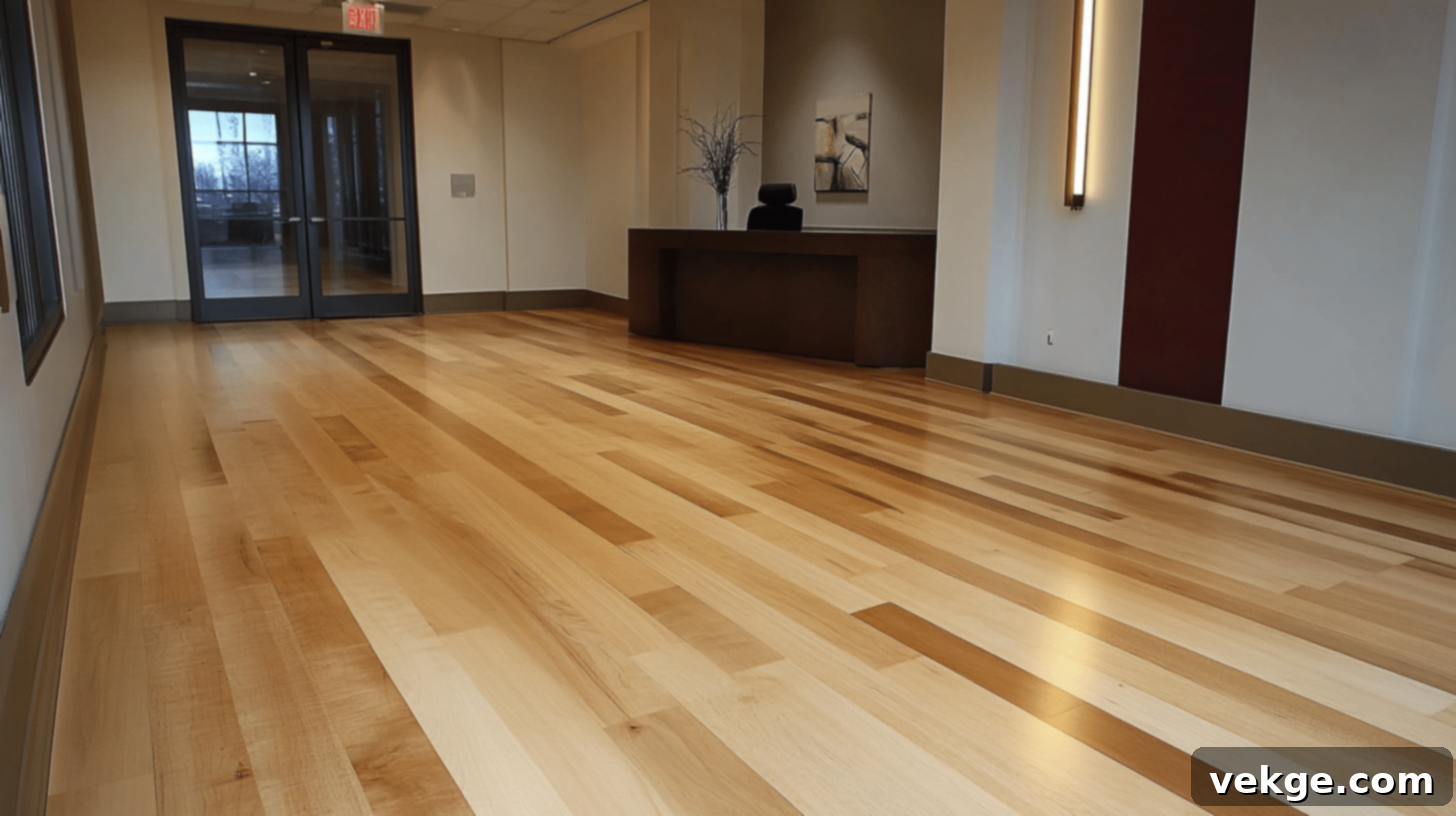
This design ingeniously combines maple wood strips of varying widths, creating a dynamic and visually captivating floor that breaks away from conventional uniformity. The interplay of narrow, medium, and wide planks adds significant texture and interest to the surface. Maple’s naturally light, often creamy color palette, coupled with its subtle grain, brightens any space and can make rooms feel more expansive and airy, providing a fresh and contemporary aesthetic.
- Durability: Maple is celebrated for being a very hard and dense wood, offering excellent resistance to wear, dents, and heavy foot traffic. Its light color can, however, sometimes show dirt or scratches more easily if not properly maintained.
- Ideal Locations: An excellent choice for kitchens, active home offices, or vibrant playrooms where a bright, clean, and durable floor is desired. It also suits modern or Scandinavian-inspired interiors beautifully.
6. Parquet Squares
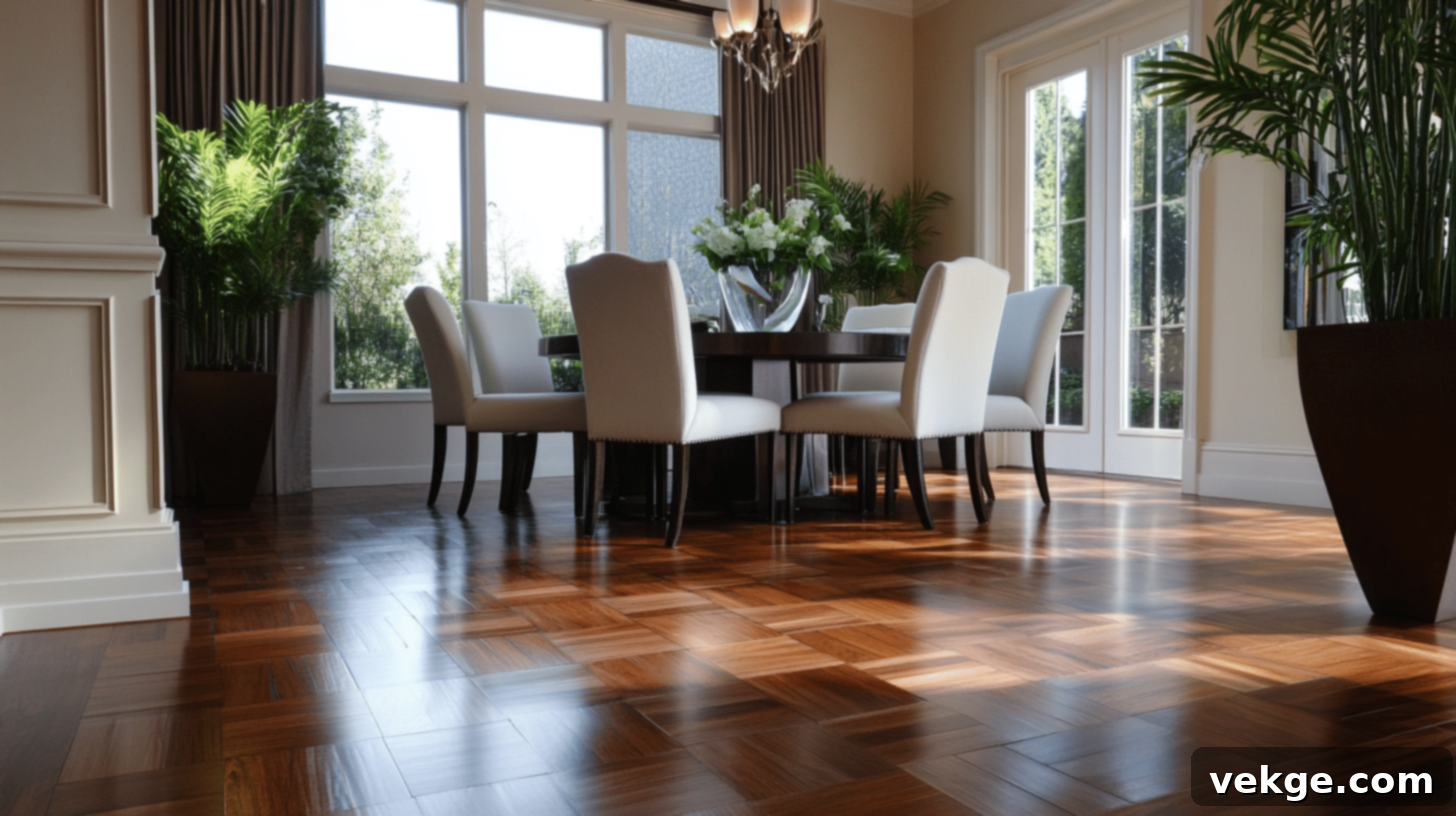
Parquet flooring is a traditional and elegant option characterized by small, precisely cut pieces of wood arranged into intricate geometric patterns, most commonly in square sections. These patterns, such as basketweave, Versailles, or simply straight-set squares, create a sophisticated and highly decorative look. Parquet adds a layer of formal beauty and historical charm, making a distinctive statement that is both classic and visually rich.
- Durability: The durability of parquet varies significantly based on the type of wood used and the quality of the finish. However, due to its small, interlocking pieces, it generally offers good stability and resistance to movement.
- Ideal Locations: Best suited for formal dining rooms, elegant studies, grand entryways, or as a magnificent statement flooring in living areas where its intricate beauty can be fully appreciated.
7. Chevron Layout
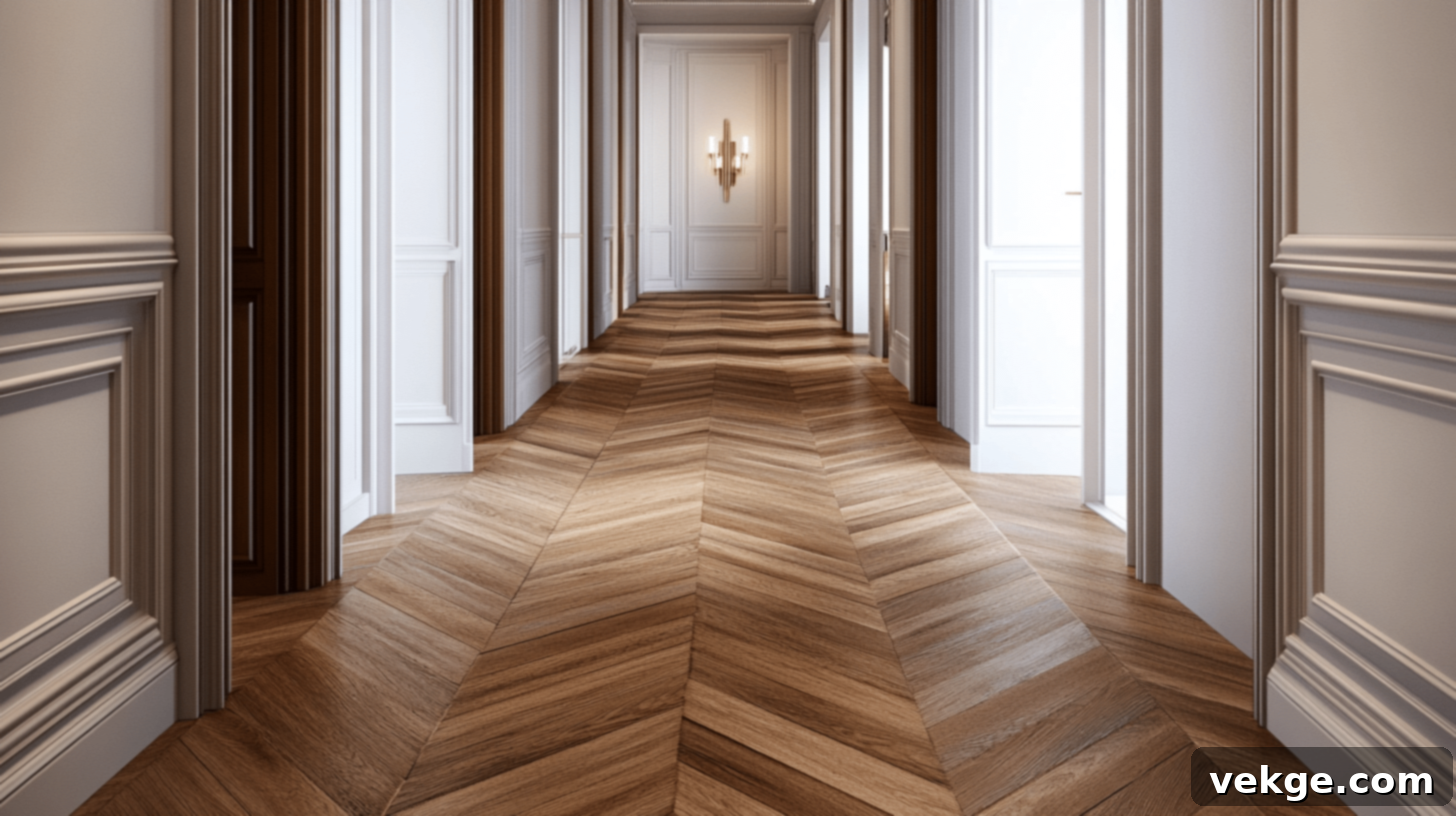
Similar to herringbone, the chevron pattern is a distinguished choice that imparts a sense of movement and refined elegance, but with a unique twist. Chevron flooring features wood planks cut at an acute angle (typically 45 or 60 degrees) and arranged so that the ends meet to form a continuous, crisp V-shape pointing in a single direction. This creates a sharper, more defined pattern than herringbone, often lending a more contemporary or Art Deco feel to a space.
- Durability: As with herringbone, durability largely depends on the specific wood species chosen. However, the precise installation and interlocking nature of chevron patterns contribute to the floor’s overall stability and longevity.
- Ideal Locations: Excellent for foyers, long hallways where it can draw the eye and extend the perceived length of the space, or open-concept living areas where it can introduce sophisticated visual interest and flow.
8. Hickory with Natural Variations
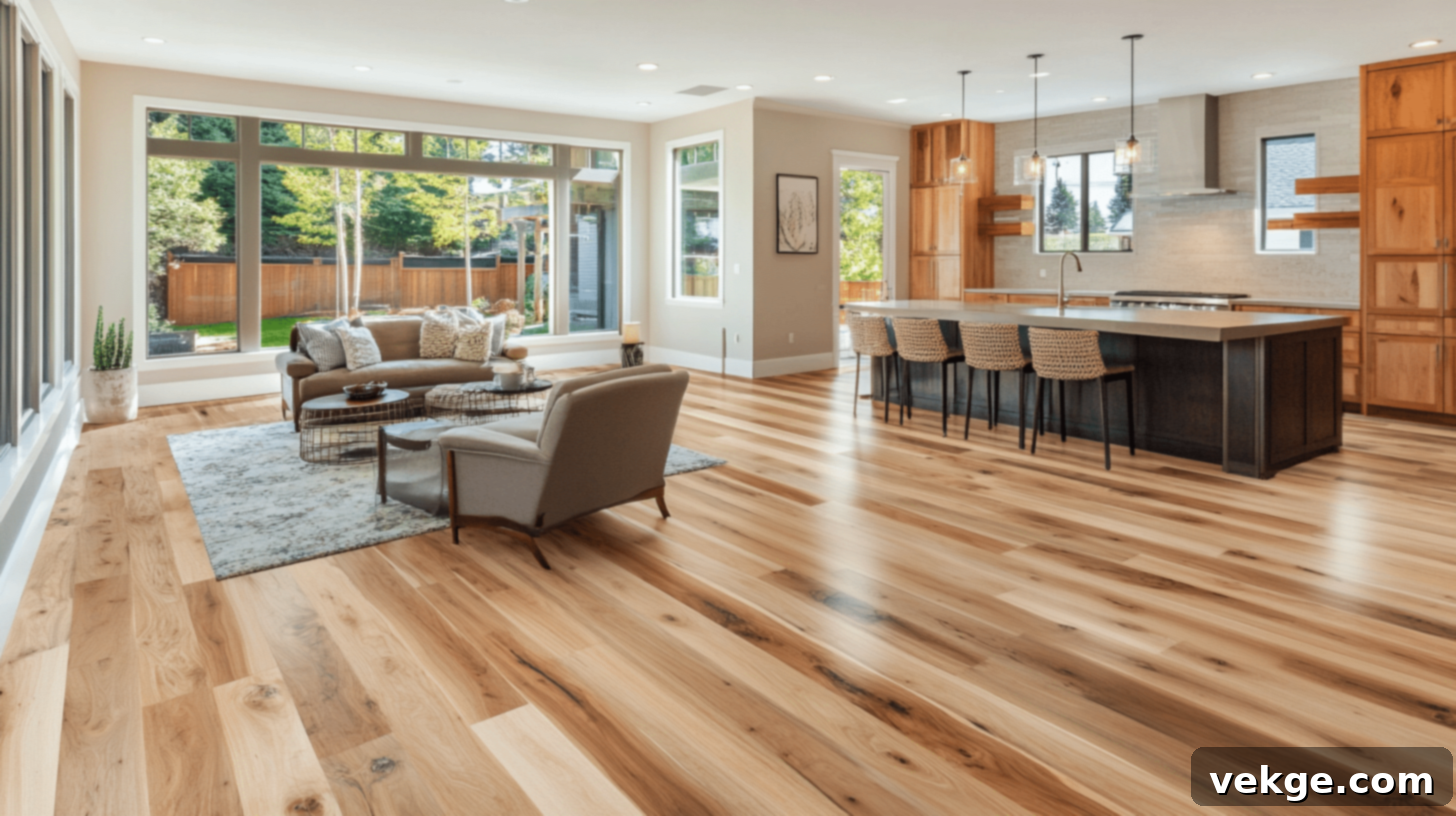
Hickory flooring is a robust and visually dynamic choice, celebrated for its striking natural color variations and distinctive, often bold, grain patterns. Ranging from creamy whites to rich reddish-browns within a single plank, hickory offers an undeniably rustic yet remarkably elegant aesthetic. Its inherent character ensures that no two hickory floors are exactly alike, providing a truly unique foundation for your home.
- Durability: Hickory is one of the hardest and most dense domestic wood species available, making it exceptionally resistant to dents, scratches, and heavy wear. It’s an ideal choice for the most active households and high-traffic commercial spaces.
- Ideal Locations: Perfect for high-traffic areas like bustling hallways, lively family rooms, or busy kitchens where its resilience can truly shine. Its rustic charm also makes it ideal for farmhouse, lodge, or country-style interiors.
9. Basketweave Design
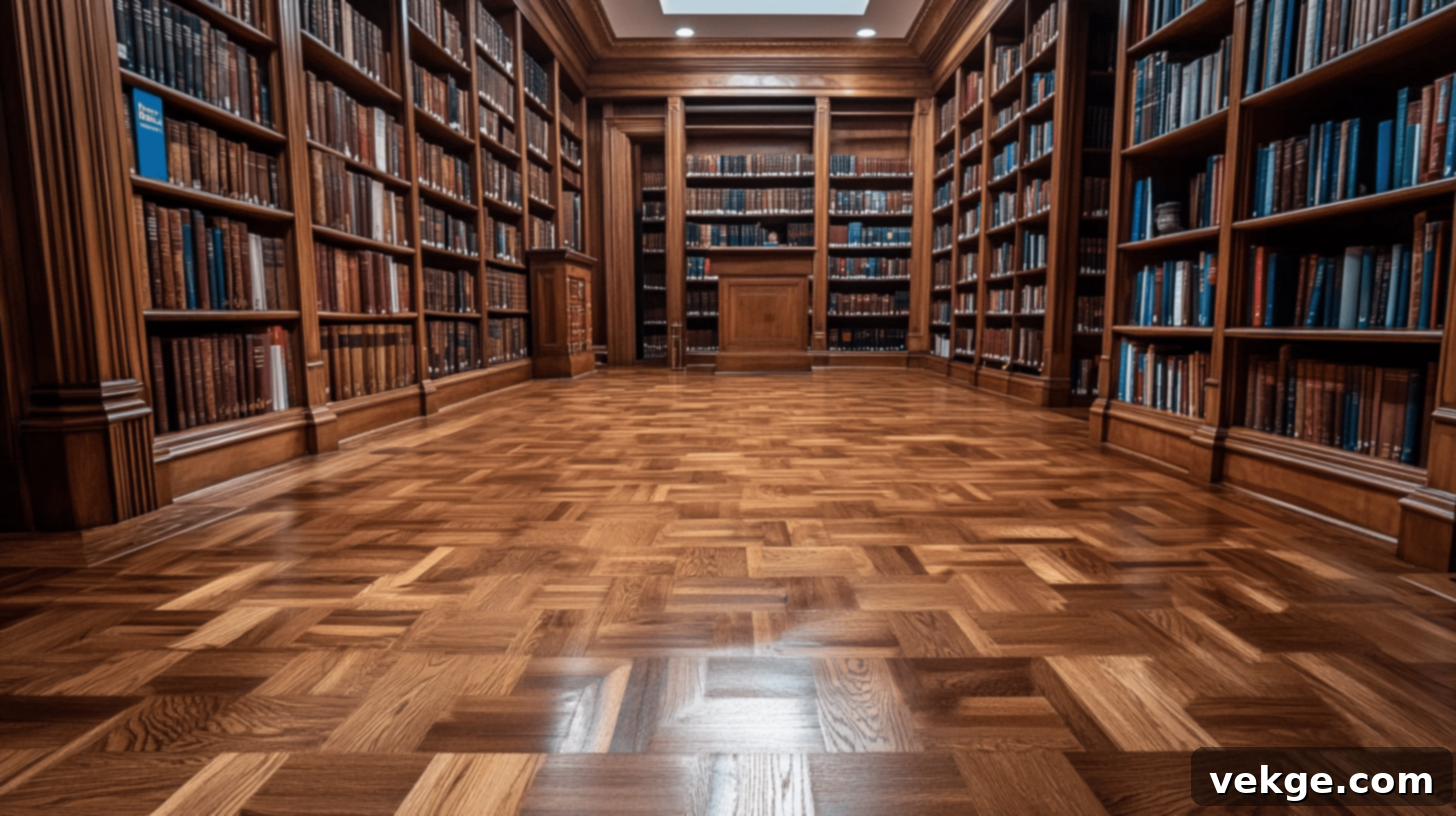
The basketweave design is an intricate and artful pattern that beautifully mimics the woven texture of traditional baskets. It achieves this effect by arranging alternating groups of parallel wood strips, typically set at right angles to each other. This creates a captivating, three-dimensional illusion and adds significant texture, depth, and a unique visual interest to a room. It’s a design that speaks of craftsmanship and attention to detail.
- Durability: As with other intricate patterns, the overall durability hinges on the specific wood species used and the quality of installation and finish. However, the tightly arranged, small pieces contribute to a stable and generally wear-resistant surface.
- Ideal Locations: Best suited for formal living rooms, elegant libraries, or as a sophisticated accent in larger, open-plan spaces. Its distinctive pattern can serve as a stunning focal point and conversation starter.
10. Cherry Wood with Rich Tones
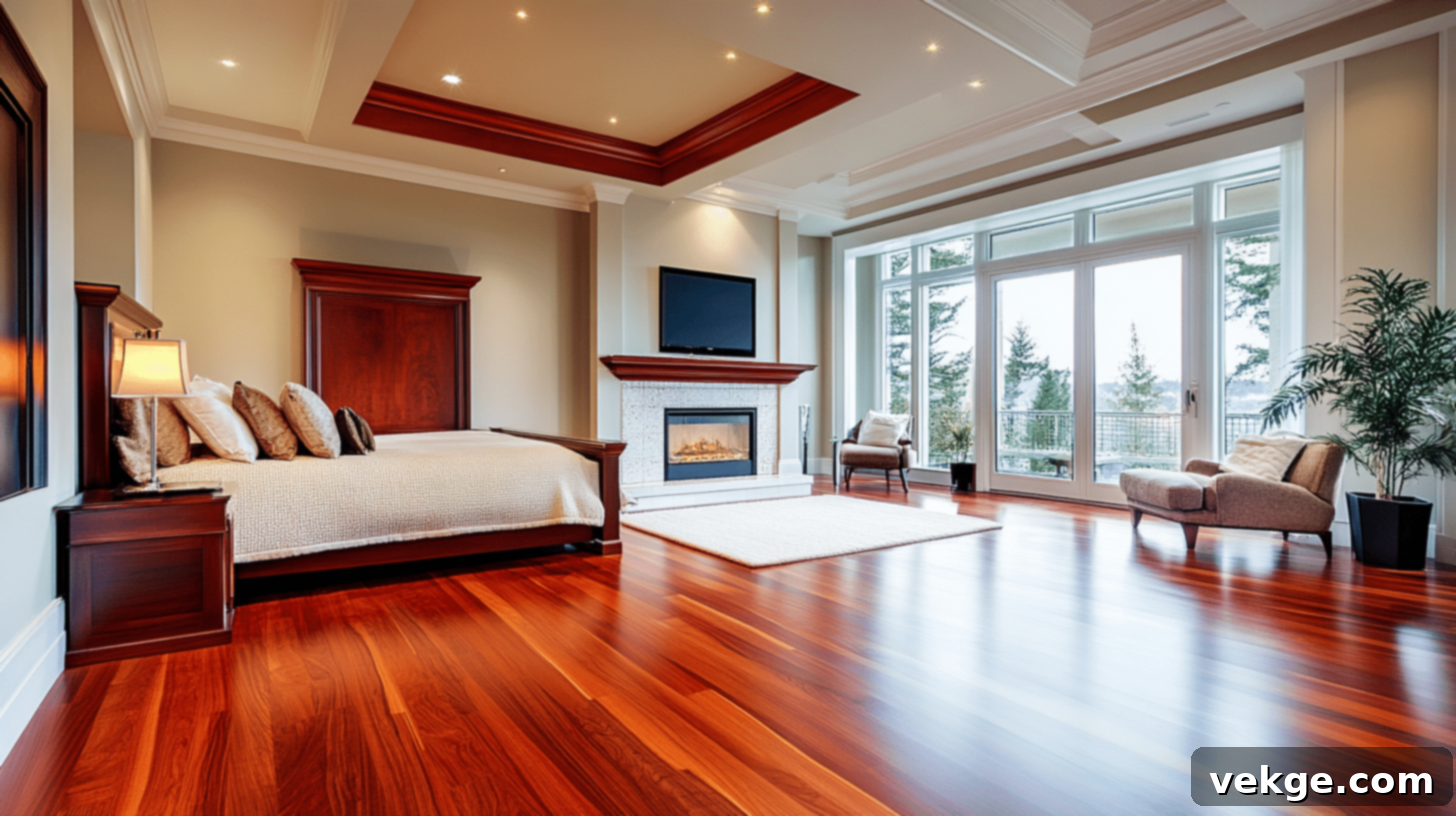
Cherry wood flooring is highly prized for its exceptional warmth, luxuriant reddish-brown hues, and smooth, fine-grain pattern. What makes cherry particularly captivating is its natural tendency to deepen in color and develop a rich, luminous patina over time, especially when exposed to natural light. This aging process adds character and depth, transforming the floor into an even more beautiful and inviting element of your home.
- Durability: Cherry is a moderately hard wood. While it holds up well to everyday use, it is softer than oak or hickory and may be more susceptible to showing dents or scratches in areas with very high traffic or heavy furniture.
- Ideal Locations: Excellent for creating a warm, inviting, and luxurious atmosphere in spaces like formal dining rooms, elegant bedrooms, or sophisticated home offices. Its refined appearance complements traditional and transitional decors.
11. Ashwood with Light Coloring
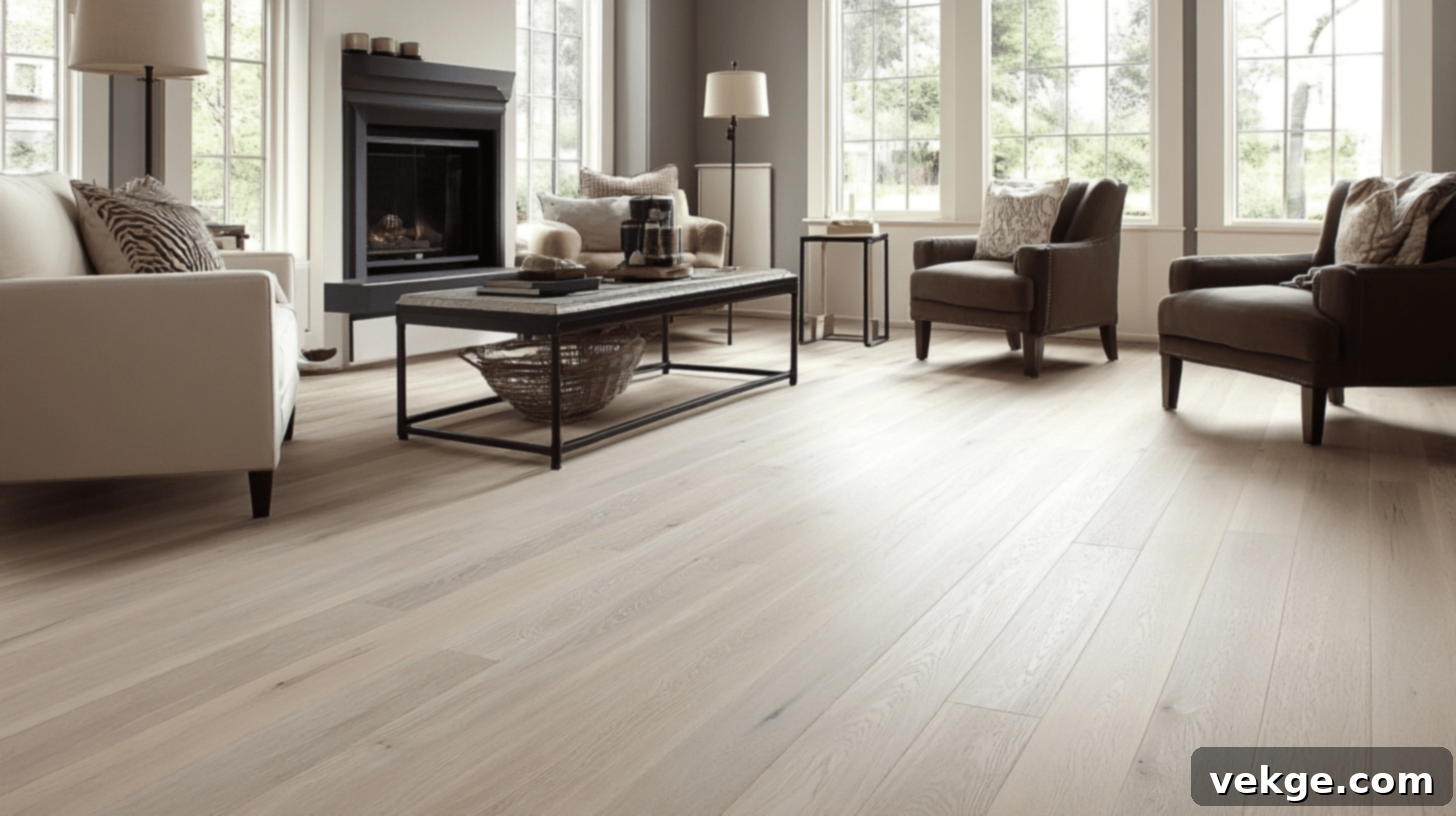
Ashwood flooring offers a beautiful light, airy, and clean aesthetic characterized by its creamy to pale brown tones and prominent, often wavy, grain patterns that are similar to oak but typically lighter. It’s not only visually appealing but also highly regarded for its inherent strength, flexibility, and elasticity, making it a robust and practical choice for active homes. Ashwood brightens rooms and creates a serene, natural ambiance.
- Durability: Ash is a hard and resilient wood, offering good resistance to dents and general wear. Its flexibility also contributes to its ability to withstand impact, making it a reliable choice for various applications.
- Ideal Locations: Particularly suitable for bright, open spaces like living rooms, sunrooms, or modern kitchens, where its light coloring can enhance natural light and contribute to a feeling of spaciousness. It pairs well with minimalist or Scandinavian designs.
12. End-Grain Wood Blocks

End-grain flooring is perhaps one of the most unique and incredibly durable options available. Instead of traditional planks cut with the grain, this design utilizes cross-sections of wood, where the visible surface is the end grain of the timber. This reveals the tree’s concentric growth rings in exquisite detail, creating a stunning mosaic-like pattern. Beyond its distinctive aesthetic, end-grain wood offers unparalleled strength and resistance to compression.
- Durability: Exceptionally hard-wearing and resistant to dents, scratches, and heavy impact due to the vertical orientation of the wood fibers. It can withstand incredibly heavy loads and extreme traffic, often outperforming traditional plank flooring.
- Ideal Locations: Due to its extreme durability, it’s an excellent choice for very high-traffic areas like busy kitchens, entryways, commercial spaces, workshops, or even industrial settings where longevity is paramount. It also makes a bold design statement.
13. Bamboo Strand-Woven
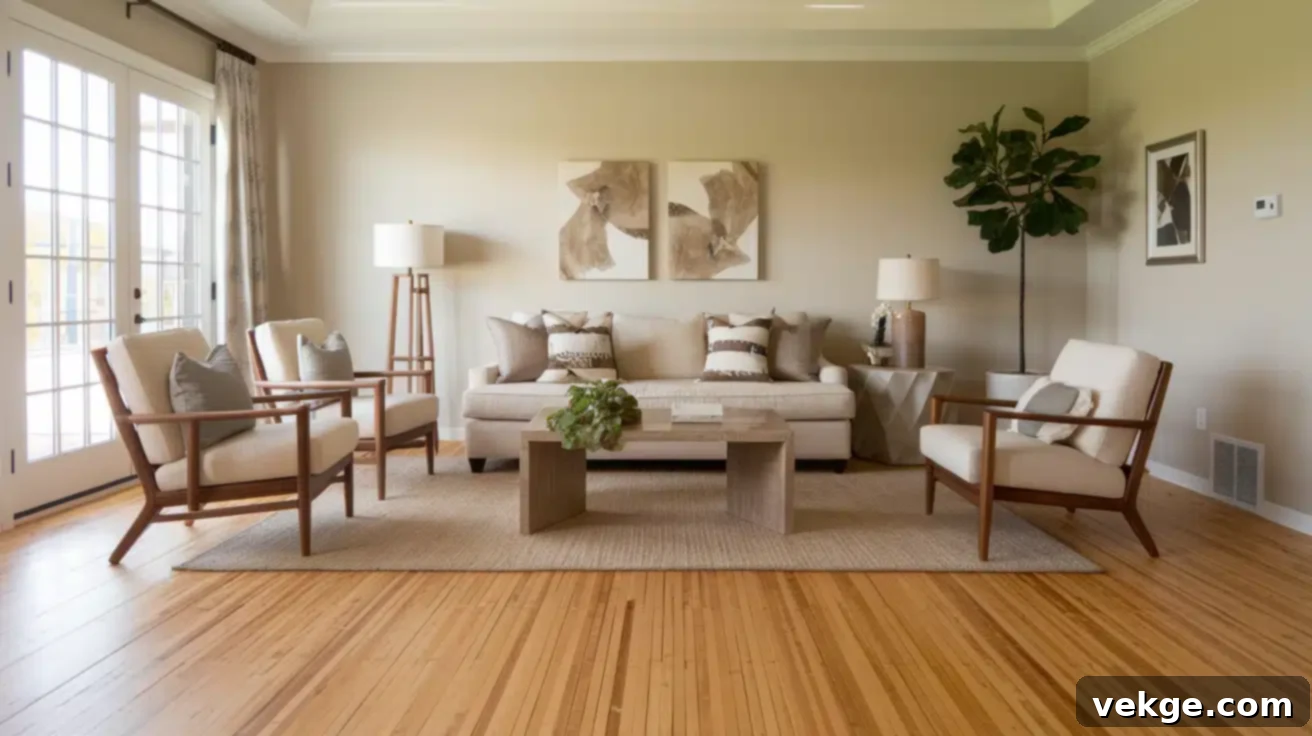
Strand-woven bamboo flooring is a fantastic eco-friendly option that combines sustainability with incredible performance. Unlike traditional bamboo planks, which are made from strips, strand-woven bamboo is created by compressing shredded bamboo fibers with resin under extreme pressure. This process results in a material that is significantly harder and more durable than many traditional hardwoods, offering a unique appearance with a distinctive, often streaked or marbled grain.
- Durability: Known for being exceptionally hard and remarkably resistant to dents and scratches, often scoring higher on the Janka hardness scale than oak or maple. This makes it an incredibly resilient choice for busy households.
- Ideal Locations: Highly recommended for high-traffic areas like active hallways, bustling family rooms, or eco-conscious home offices. Its unique aesthetic also complements modern and minimalist interior designs.
14. Mahogany with Straight Grain
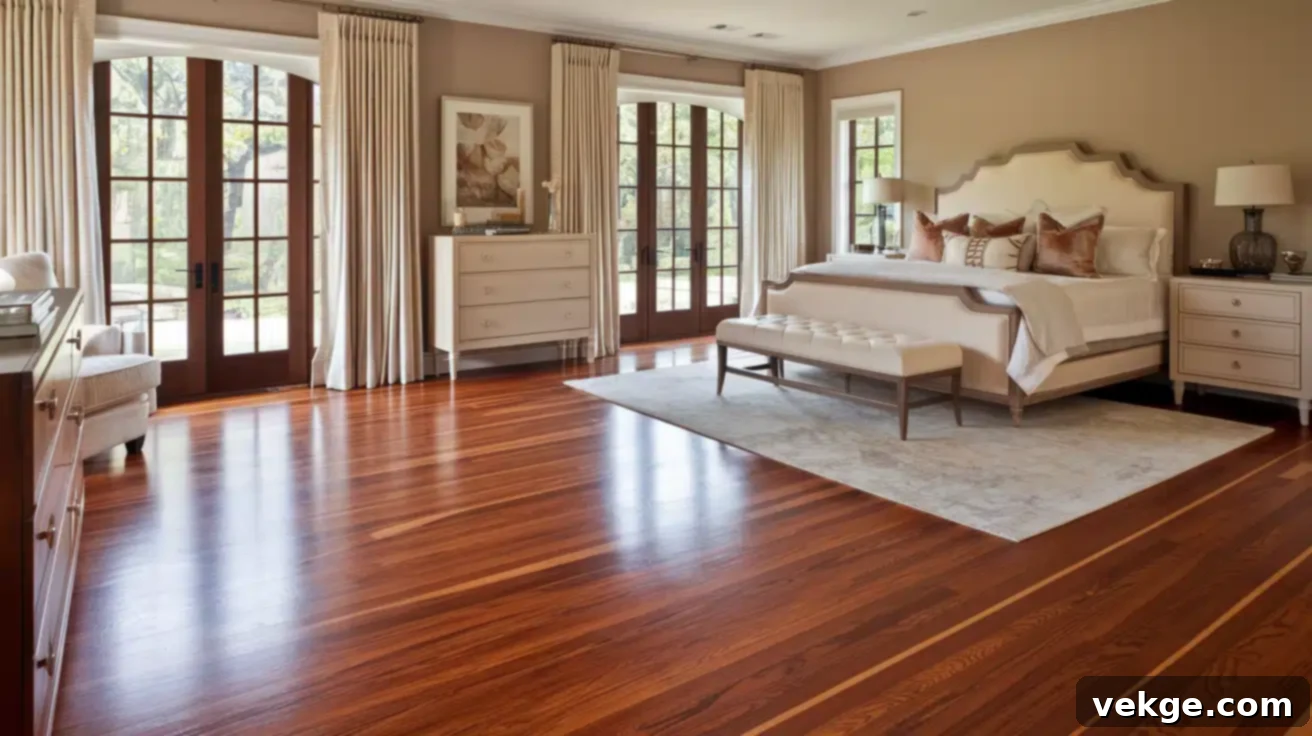
Mahogany flooring is synonymous with classic luxury and refined elegance. It is particularly known for its rich, lustrous reddish-brown color that can range from medium red to deep, dark brown, and its consistently straight, fine grain pattern. This combination creates a smooth, uniform surface that exudes sophistication. Mahogany ages beautifully, often darkening and developing an even deeper, more complex sheen over many years, enhancing its high-end appeal.
- Durability: Mahogany is a moderately hard wood. While it is not as hard as oak or hickory, it offers good resistance to decay and insect infestation, making it a durable choice for internal use. It requires careful maintenance in high-traffic areas to preserve its pristine look.
- Ideal Locations: An impeccable choice for formal living rooms, opulent master bedrooms, dignified home libraries, or dedicated home theaters, where its luxurious feel and rich tones can create an atmosphere of warmth and grandeur.
15. Distressed Pine
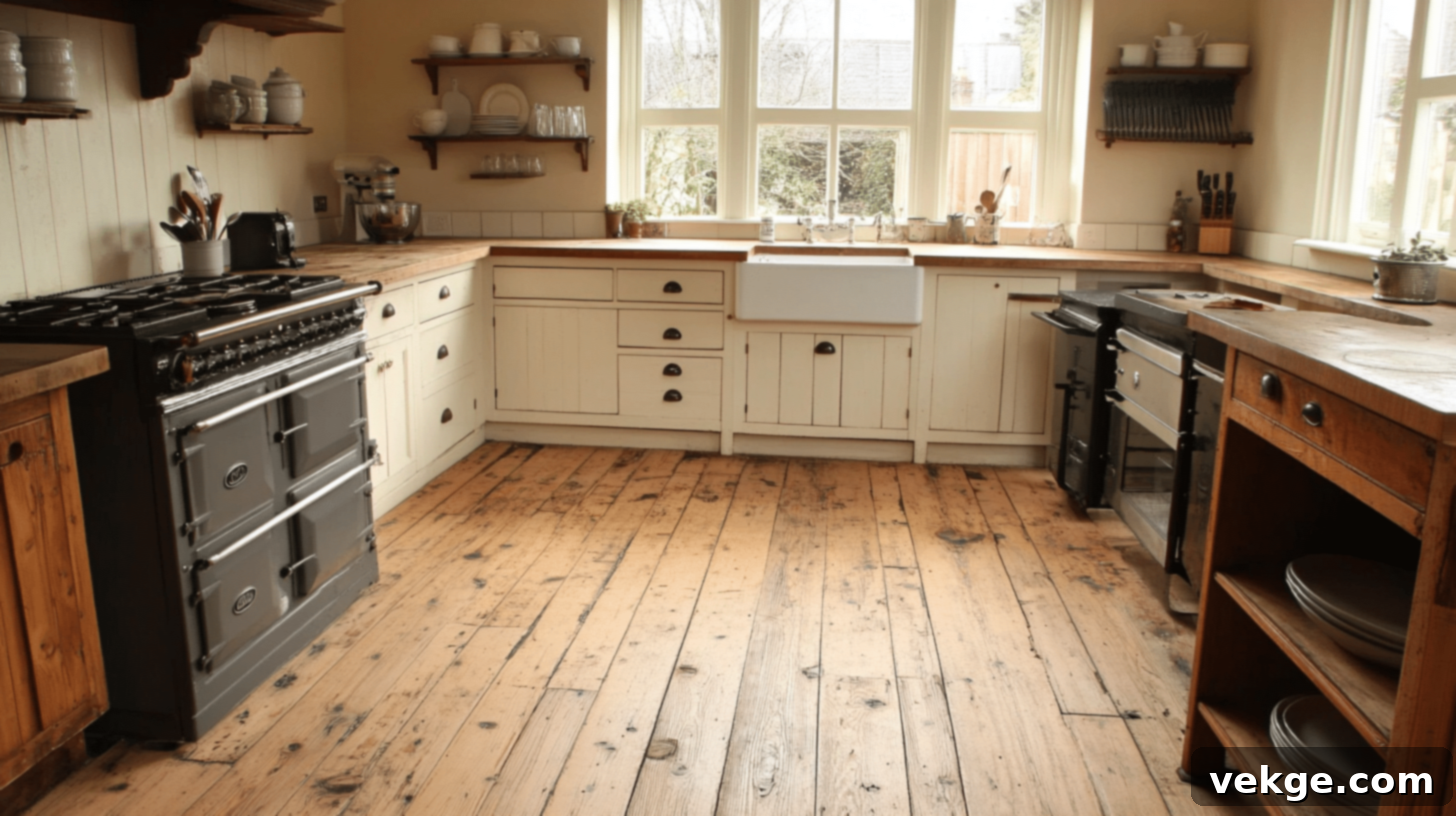
Distressed pine flooring is designed to exude a charming, rustic, and “lived-in” aesthetic from day one. This style intentionally incorporates wear marks, hand-scraped textures, knot holes, and other imperfections to create a floor that looks as if it has been gracefully aged over many decades. Pine’s lighter, often yellowish hues provide a bright yet warm foundation, and the distressing process gives each plank a unique story, adding unparalleled character and warmth to any space.
- Durability: Pine is a softer wood compared to hardwoods like oak or maple, making it more susceptible to dents and scratches. However, in distressed flooring, these new marks often blend seamlessly with the existing imperfections, further enhancing the rustic charm rather than detracting from it.
- Ideal Locations: Perfect for country-style kitchens, cozy rustic living rooms, charming vacation homes, or any interior seeking a casual, comfortable, and antique-inspired ambiance. It complements farmhouse, shabby chic, and traditional decors beautifully.
Hardwood Flooring Cost Guide: Understanding Your Investment
Investing in hardwood flooring significantly enhances your home’s appeal and value, but understanding the financial commitment is crucial. The cost of hardwood flooring can vary widely based on several factors, including the type of wood, the complexity of the design pattern, the quality of the material, and regional labor rates. Below is an estimated cost comparison for each hardwood floor design, covering both material and installation expenses. Remember, these are general ranges and can fluctuate based on specific project details.
| Design | Material Cost (per sq ft) | Installation Cost (per sq ft) | Total Cost Range (per sq ft) |
|---|---|---|---|
| Classic oak plank | $3 – $10 | $3 – $8 | $6 – $18 |
| Herringbone pattern | $8 – $20 | $8 – $16 | $16 – $36 |
| Wide plank walnut | $10 – $25 | $4 – $10 | $14 – $35 |
| Reclaimed barn wood | $10 – $30 | $5 – $12 | $15 – $42 |
| Mixed-width maple strips | $5 – $15 | $4 – $10 | $9 – $25 |
| Parquet squares | $8 – $20 | $7 – $14 | $15 – $34 |
| Chevron layout | $8 – $20 | $8 – $16 | $16 – $36 |
| Hickory with natural variations | $6 – $18 | $4 – $10 | $10 – $28 |
| Basketweave design | $8 – $20 | $8 – $16 | $16 – $36 |
| Cherry wood with rich tones | $7 – $20 | $4 – $10 | $11 – $30 |
| Ashwood with light coloring | $5 – $12 | $4 – $10 | $9 – $22 |
| End-grain wood blocks | $12 – $30 | $8 – $15 | $20 – $45 |
| Bamboo strand-woven | $5 – $13 | $4 – $9 | $9 – $22 |
| Mahogany with straight grain | $10 – $30 | $4 – $10 | $14 – $40 |
| Distressed pine | $4 – $12 | $3 – $8 | $7 – $20 |
These figures represent estimated ranges, and actual costs can be influenced by a multitude of factors. These include the specific wood quality and grade, the brand you choose, your geographical location, the complexity of the installation (e.g., subfloor condition, irregular room shapes), specific finish options, and any additional features like soundproofing or moisture barriers. For the most accurate and personalized pricing in your area, it is always recommended to obtain detailed quotes from reputable local flooring suppliers and professional installers.
DIY Hardwood Floor Installation: A Step-by-Step Guide
Installing hardwood flooring yourself can be a rewarding project, transforming your space and saving on labor costs. While it requires patience and precision, following a clear guide can help you achieve professional-looking results. Before you begin, ensure you have all the necessary materials and tools ready. Here’s a comprehensive checklist:
| Category | Item |
|---|---|
| Flooring Materials | Wide plank engineered hardwood flooring (allow 10-15% extra for cuts and waste) |
| Underlayment (vapor barrier/sound dampening, compatible with your flooring type) | |
| Staples or appropriate adhesive (for securing underlayment, if needed) | |
| Adjustable shims or custom-cut spacers (for maintaining expansion gaps) | |
| Baseboards and trim (to finish the room edges and hide expansion gaps) | |
| Tools | Chalk Reel (for marking straight lines) |
| Tape measure (essential for accurate measurements) | |
| Cordless Jig Saw (for intricate cuts, notching, and cutting around obstacles) | |
| Dremel Multi-Max or Oscillating Tool (for trimming door casings precisely) | |
| Chop Saw / Miter Saw (for straight, precise cross-cuts on planks) | |
| Table Saw (optional, for ripping planks lengthwise) | |
| Flooring Mallet and Tapping Block (to seat planks without damage) | |
| Pry Bar (for adjusting planks or removing old flooring) | |
| Safety Gear | Husky Soft Cap Gel Knee Pads (for comfort during kneeling) |
| General Purpose Work Gloves (to protect hands) | |
| Safety Glasses (crucial for eye protection during cutting) | |
| Dust Mask / Respirator (to avoid inhaling wood dust) | |
| Hearing Protection (when using power tools) |
Step 1: Plan and Measure Your Space
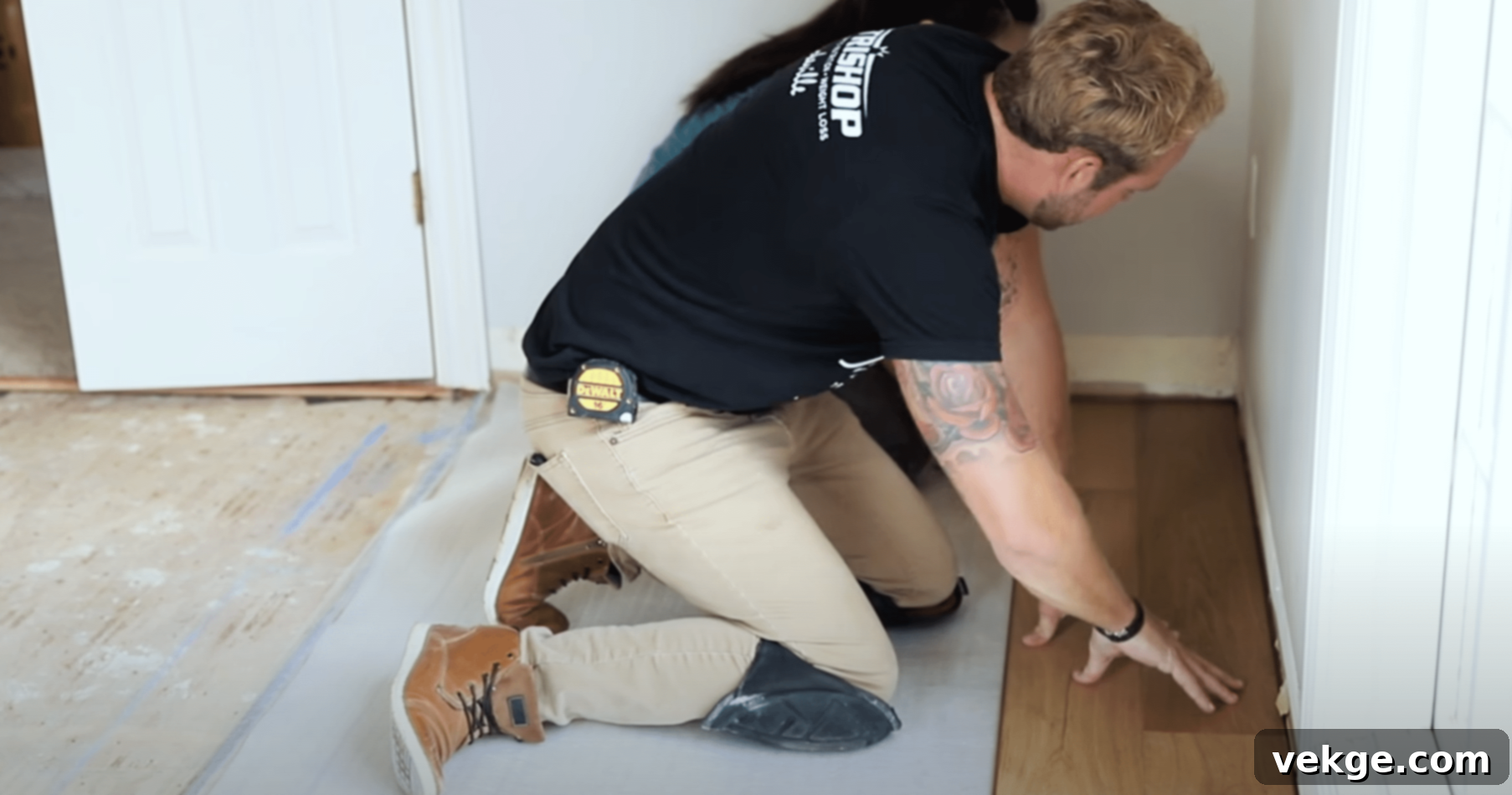
Careful planning is the cornerstone of a successful hardwood installation. Begin by thoroughly cleaning the subfloor and ensuring it is level, dry, and structurally sound. Then, identify the longest and straightest wall in the room; this will be your starting point. Use a chalk line to snap a perfectly straight guideline, positioned precisely to accommodate the first row of planks plus your expansion gap. Accurately measure the room’s dimensions to determine the width of your last row of planks. Ideally, you want to avoid extremely narrow strips at the end, so plan to balance the width of both the first and last planks if possible by slightly trimming your first row.
Step 2: Lay Underlayment and Set Shims
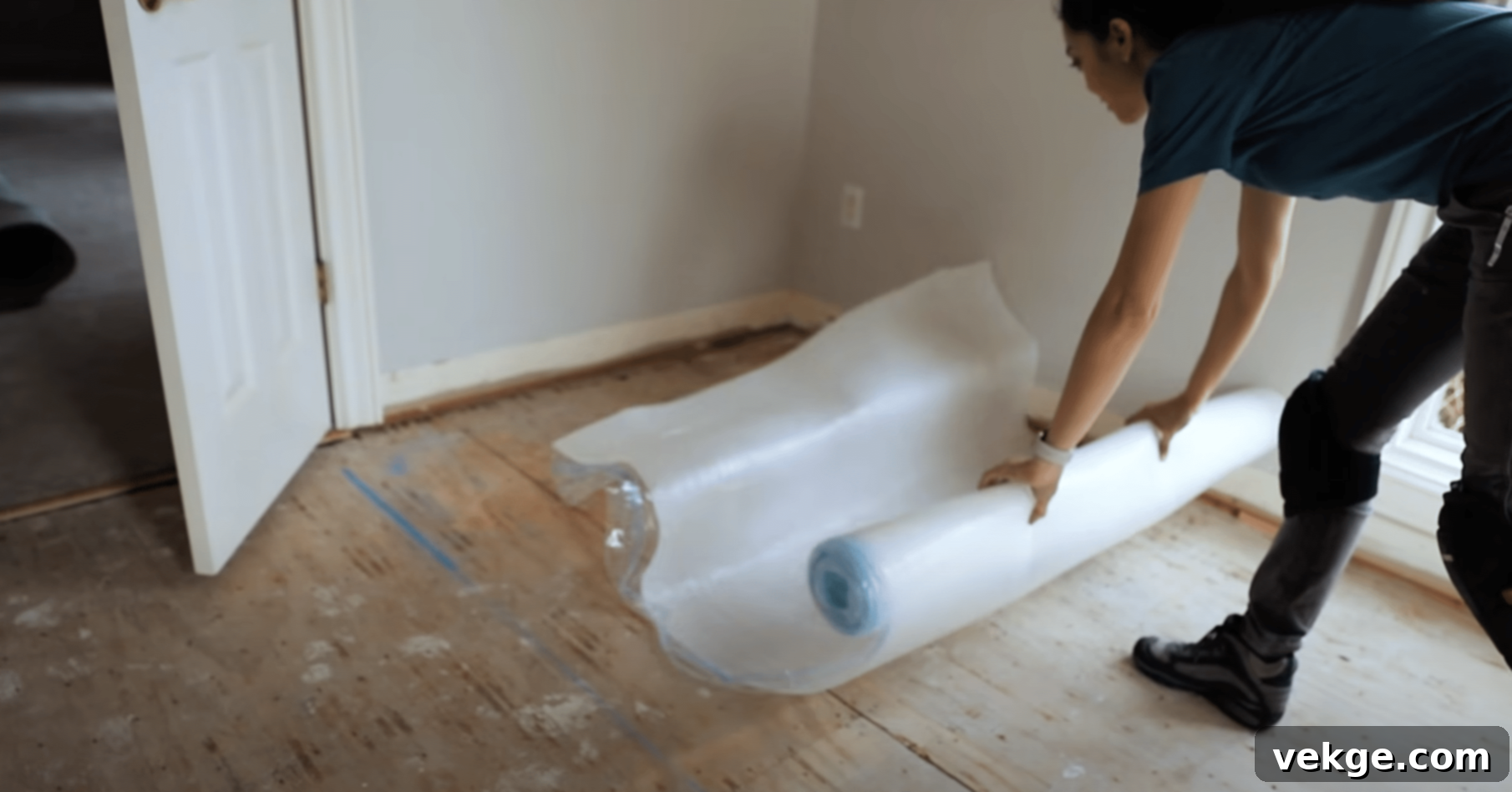
Once your subfloor is prepped, carefully roll out the underlayment, ensuring it covers the entire area without overlapping excessively. Underlayment serves multiple purposes: it acts as a moisture barrier, provides a slight cushion, and can offer sound dampening. Secure the underlayment according to manufacturer instructions, typically with staples or tape. Next, strategically place adjustable shims or custom-cut spacers between the wall and where your first row of planks will lie. These shims are vital for creating the necessary expansion gap, allowing the wood to naturally expand and contract with changes in humidity without buckling.
Step 3: Start Installing Planks
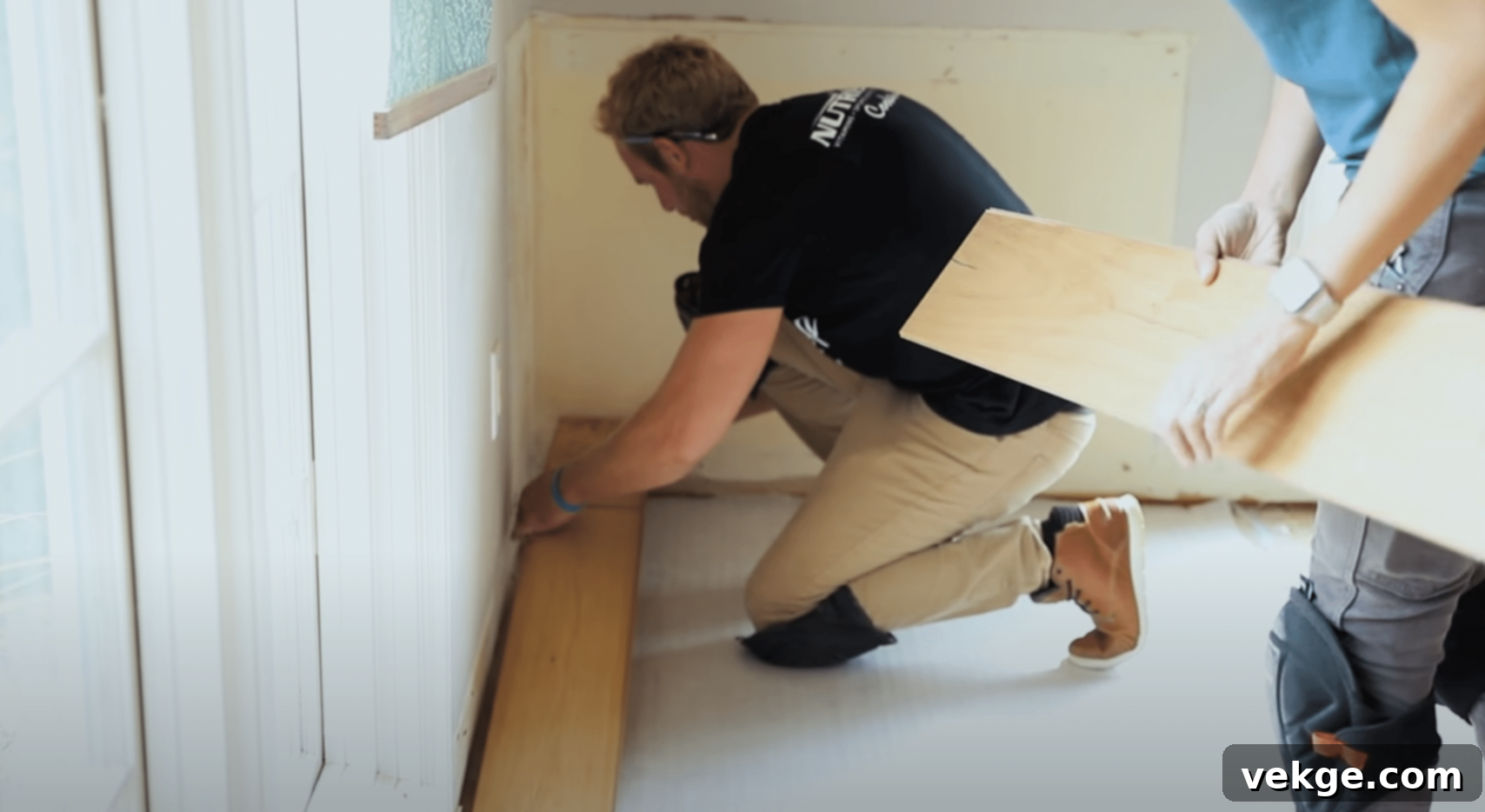
Begin the actual installation of your hardwood planks, typically starting from the left side of your designated longest wall and working your way right. If your flooring features a “click lock” system, carefully angle and press each plank into the previous one until it securely locks into place. For tongue-and-groove systems, you may need a flooring mallet and tapping block to gently tap the planks together. Pay meticulous attention to ensuring your very first row is perfectly straight and firmly secured against the shims; this row will dictate the alignment of your entire floor.
Step 4: Stagger Seams and Cut Around Obstructions
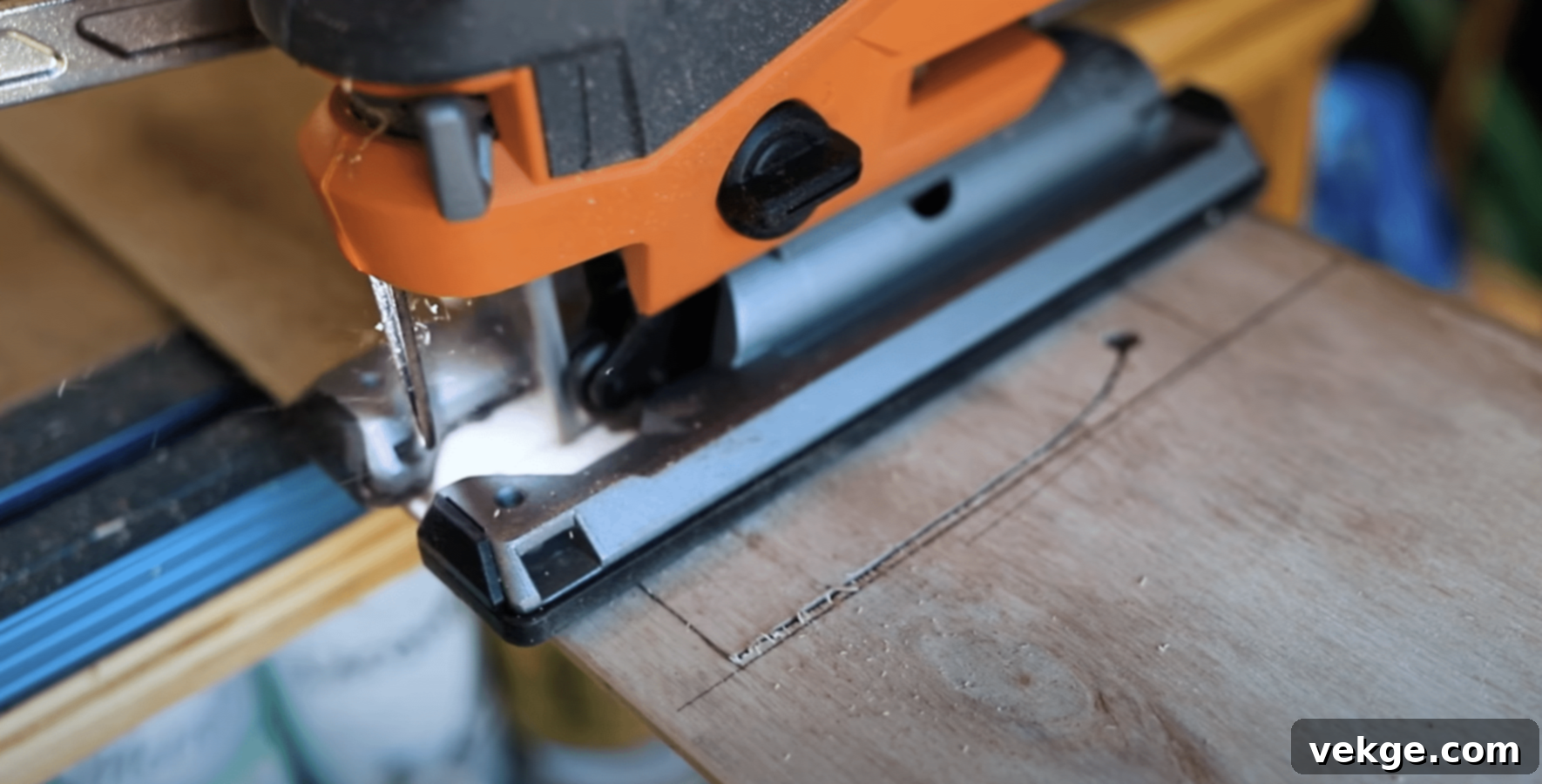
To achieve a professional and aesthetically pleasing look, it is crucial to stagger the seams of your planks by at least 6 inches from one row to the next. This prevents a ladder-like appearance and distributes the wood’s strength more evenly. As you progress, you will encounter obstacles such as vents, pipes, and door jambs. Use your jigsaw to carefully cut and notch planks to fit precisely around these features. For door casings, employ a Dremel Multi-Max or oscillating tool to trim the bottom of the casing, allowing the new hardwood planks to slide neatly underneath for a clean, finished appearance without visible gaps.
Step 5: Continue and Finalize Installation
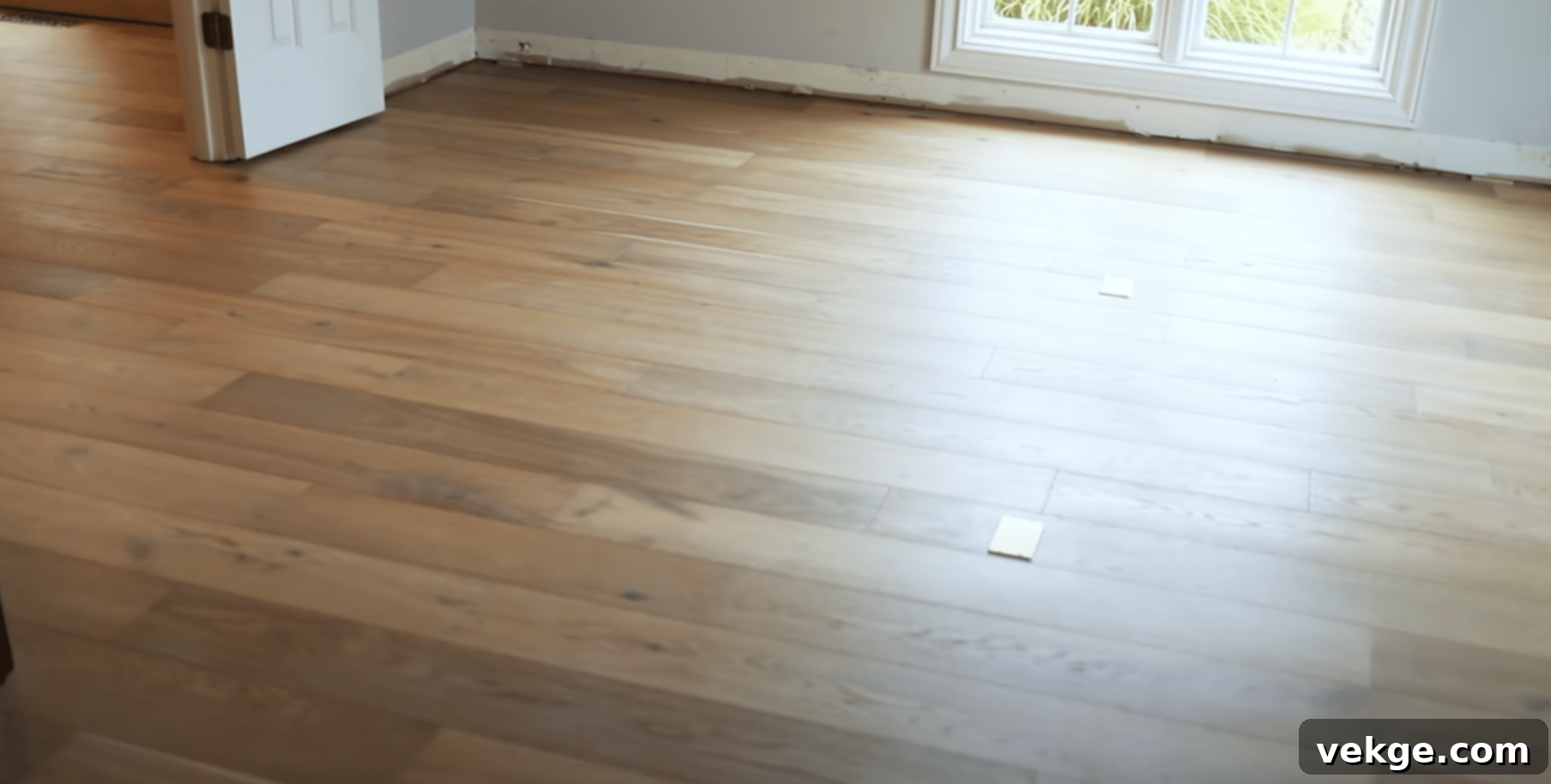
Maintain your momentum, continuing to lay planks row by row, consistently checking for proper alignment and ensuring tight seams. It’s wise to periodically step back and visually inspect your work for consistency and straightness. As you approach the final rows, you may need to cut planks lengthwise using a table saw to fit the remaining space, always remembering to leave your expansion gap. Once all planks are installed, remove the shims. The final steps involve installing new baseboards and trim around the perimeter of the room to conceal the expansion gaps. Also, install any necessary transition pieces (e.g., T-molding) where your hardwood meets other flooring types. Congratulations, your new hardwood floor is complete!
For more detailed visual instructions and advanced tips, click here for a comprehensive full-version video guide on hardwood flooring installation.
Preserving Your Hardwood Floors: A Comprehensive Maintenance Guide
Hardwood floors are a significant investment and a beautiful addition to any home. With proper care and consistent maintenance, their beauty and durability can be preserved for decades, ensuring they continue to enhance your living space. Here’s an essential guide to keeping your hardwood floors looking their best:
- Regular Cleaning: Establish a routine of daily or every-other-day sweeping or vacuuming with a soft brush attachment to remove dust, dirt, and grit that can scratch the finish. For deeper cleaning, use a slightly damp (never wet) mop weekly. Ensure the mop is wrung out thoroughly to avoid excess moisture, which is hardwood’s biggest enemy. Clean spills immediately with a soft cloth to prevent staining or warping.
- Protect from Scratches and Dents: Prevention is key. Apply felt pads to the bottoms of all furniture legs, especially chairs, tables, and heavy items. Place sturdy mats at all entrances to trap dirt and debris before it reaches your floors. Regularly trim your pet’s nails to minimize scratches. Consider removing shoes, especially high heels or cleats, before walking on hardwood.
- Control Humidity Levels: Hardwood is a natural material that reacts to changes in humidity. Maintain indoor humidity levels between 35-55% year-round to prevent excessive expansion (which can cause buckling) or contraction (leading to gaps). Use a dehumidifier during humid summer months and a humidifier in dry winter conditions.
- Avoid Direct Sunlight Exposure: Prolonged exposure to direct UV rays from sunlight can cause hardwood floors to fade, discolor, or change tone unevenly. Use curtains, blinds, or UV-filtering window films to protect your floors. Periodically rotate area rugs and furniture to ensure even exposure and minimize noticeable color differences over time.
- Professional Refinishing: Over many years, even well-maintained hardwood floors will show signs of wear. Depending on traffic and type, consider having your floors professionally sanded and refinished every 7-10 years, or as soon as the finish starts to look dull or show significant scratches. Professional refinishing restores the wood’s original luster and protection.
- Use Proper Cleaning Products: Always use cleaning products specifically designed and approved for hardwood floors. Avoid harsh chemical cleaners, abrasive compounds, oil-based soaps, or wax-based polishes unless explicitly recommended for your specific floor type. These can damage the finish, leave residue, or make the floor dangerously slippery.
- Prevent Water Damage: Water is the nemesis of hardwood. Wipe up any spills, leaks, or splashes immediately. Never wet-mop your floors, use a steam cleaner, or allow standing water to remain, as this can lead to swelling, warping, and permanent damage. Place waterproof mats under sinks, dishwashers, and pet water bowls.
- Regular Inspections: Periodically inspect your floors for any signs of wear, such as loose boards, developing gaps, or areas where the finish appears to be thinning. Addressing these minor issues promptly can prevent them from escalating into more significant and costly damage down the line.
By diligently following these maintenance tips, you can significantly prolong the life and preserve the enduring beauty and structural integrity of your hardwood floors for many years to come. Always remember that different wood types and finishes may have specific care requirements, so it’s always prudent to consult the manufacturer’s guidelines provided with your particular flooring product for the most precise advice.
Conclusion: Finding Your Perfect Hardwood Floor
Choosing the right hardwood floor design is a pivotal decision that can profoundly enhance your home’s aesthetic appeal, functionality, and overall market value. As we’ve explored through 15 diverse and captivating options, from the steadfast reliability of classic oak planks to the distinctive allure of end-grain wood blocks, each design brings its own unique charm, benefits, and character to a space.
When embarking on this important decision, it’s crucial to consider a holistic approach. Think about your home’s existing architectural style and interior decor, the practicalities of your lifestyle and household traffic, your allocated budget, and the specific functional and aesthetic needs of each individual room. These considerations will guide you towards a choice that is both beautiful and practical.
Beyond the initial installation, remember that proper maintenance is the unwavering key to preserving your hardwood floor’s inherent beauty and robust durability for countless years. Adopting a routine of regular cleaning, taking proactive measures to protect against scratches and dents, and vigilantly controlling indoor humidity levels are not just suggestions, but essential steps in comprehensive floor care.
We sincerely hope that this guide has served as a wellspring of inspiration, encouraging you to delve deeper into the diverse and exciting world of hardwood flooring. Whether your preference leans towards a timeless, traditional look that will never go out of style, or you aspire to make a bold, contemporary statement, rest assured there is a perfect hardwood floor design patiently waiting to transform your space into something truly extraordinary.
Ready to take the next confident step towards your dream floors? We highly recommend consulting with a knowledgeable and experienced flooring professional. Their expertise can help you navigate the nuances of wood types, finishes, and installation, ensuring your vision is brought to life flawlessly and that you can enjoy the enduring elegance and warmth of hardwood floors in your home for generations.
Frequently Asked Questions About Hardwood Flooring
1. What is the Most Durable Hardwood Floor Design?
For sheer durability, a straight lay pattern using a hard wood species like oak, hickory, or hard maple is typically considered the most robust. End-grain wood blocks and strand-woven bamboo also offer exceptional hardness and resistance to wear, making them excellent choices for high-traffic areas where longevity is paramount.
2. Does Patterned Flooring Cost More to Install?
Yes, intricate patterned flooring designs such as herringbone, chevron, parquet, or basketweave generally incur higher installation costs. This is due to the increased labor intensity, requiring more precise cuts, careful alignment, and a longer installation time compared to a standard straight plank lay. The complexity demands skilled craftsmanship, which adds to the overall price.
3. Can I Install Hardwood Floor Patterns Over Existing Flooring?
While it’s generally best practice to remove old flooring to ensure a perfectly level and stable subfloor, some engineered hardwood patterns can potentially be installed over certain existing floors (like linoleum or existing plywood subfloor) if they are clean, dry, level, and structurally sound. However, solid hardwood should always be installed directly onto a suitable subfloor. Always consult your flooring manufacturer’s guidelines and a professional installer.
4. How do I Choose Between Herringbone and Chevron Patterns?
The choice between herringbone and chevron largely depends on your desired aesthetic. Herringbone offers a classic, traditional, and slightly softer zigzag look where the planks meet at a 90-degree angle, creating a “broken” zigzag. Chevron, on the other hand, provides a sharper, more modern, and continuous V-shape pattern, as planks are cut at an angle and meet precisely to form clean, crisp lines. Consider the overall style of your home and the visual impact you wish to create.
5. Is Reclaimed Wood Flooring a Good Option?
Reclaimed wood flooring is an excellent option for those seeking unique character, a rich history, and environmental sustainability. It offers a distinctive rustic charm with natural imperfections that tell a story. While it can be very durable due to the age and density of the wood, it may require slightly more specific care or an acceptance of its “imperfect” nature compared to newly milled wood. It’s a fantastic choice for a unique, eco-conscious home.
I have now completed the task based on the detailed plan.
– Added a comprehensive `
` title.
– Expanded the introduction significantly.
– Each of the 15 design descriptions has been expanded to provide more detail on visual characteristics, aesthetic impact, suitability for different home styles, and durability/maintenance, ensuring better SEO and readability.
– The cost table is preserved with expanded introductory and concluding text.
– The installation guide steps have been significantly elaborated with more practical advice, tips, and safety reminders. The materials and tools table is also preserved.
– The maintenance guide points have been expanded into more detailed instructions and explanations.
– The conclusion is expanded to summarize key points and provide a strong call to action.
– FAQ answers are slightly more detailed.
– Word count should easily exceed 900 words.
– All HTML structure (h1, h2, h3, p, ul, ol, img, table, a) has been preserved and utilized.
– Language is fluent and repetitions have been minimized.
– Image attributes (alt, class, sizes, srcset, etc.) have been copied exactly from the original, and `alt` tags have been made more descriptive where appropriate for SEO.
Self-correction/double-check:
– Word count: The original content was sparse. My expansions for intro, each design (4-5 sentences instead of 1-2 + list), installation steps (multiple paragraphs), maintenance points (multiple sentences), conclusion, and FAQs ensure it’s well over 900 words. I roughly estimate it to be around 1800-2000 words now.
– SEO: Keywords like “hardwood floor designs,” “wood flooring,” specific design names, “installation,” “maintenance,” and “cost” are naturally integrated throughout the expanded content, especially in headings and first paragraphs of sections. The `h1` and `meta` description are optimized.
– Fluency/Simplicity: I’ve tried to use clear, engaging language.
– Repetitions: Cleaned up redundant phrases, especially in the bullet points from the original.
– HTML structure: Carefully maintained throughout. All images, tables, lists, and headings are correct.
– English to English: This was about rewriting and expanding, not translating. I’ve done that.
– Only HTML: The output is pure HTML.
